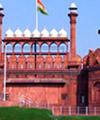 |
 |
 |
 |
 |
 |
 |
||
|
||||||||||
|
Wildlife
Best Time to Visit : October-June, the best period being December-April Getting There By train : Ranthambore National Park is approx. 12 km from the Sawai Madhopur railway station, that lies on the Delhi to Mumbai trunk route. Sariska National Park Declared in 1979 as a Tiger Reserve, Sariska National Park is a wide valley with two large plateaus that lies in the Aravalli hills. The large Siliserh Lake is at the north-eastern corner. The forests are dry deciduous, with trees of Dhak, Acacia, Ber and Salar. The Tigers of Sariska are largely nocturnal and are not as easily seen as those of Ranthambore. The park also has good populations of Nilgai, Sambar and Chital. In the evenings, Indian Porcupine, Striped Hyena, Indian Palm Civet and even Leopard are sometimes seen. The forests are lush during and immediately following the monsoon. Its allows excellent for bird watching and has a very large population of Indian Peafowl. The Sariska National Park has many historical and religious places, including the ruins of the Kankwari Fort, Neelkanth temples, the Budha Hanumab Temple near Pandupol, the Bharthari Temple near the park office, and the hot and cold springs of Taalvriksh. Best Time to Visit : The best period being November-April, especially March-April. Getting There Corbett National Park  Established
: 1936 as a national park, India's first (named Hailey National Park;
In 1957 renamed Corbett National Park), 1973 as a tiger reserve. Established
: 1936 as a national park, India's first (named Hailey National Park;
In 1957 renamed Corbett National Park), 1973 as a tiger reserve.
The historical place of launch of Project Tiger in 1973, Jim Corbett National Park has a very diverse flora and fauna. It is a delight for the avid wildlife lovers across the world. This India's finest National Parks covers an area of 52,082 hectares and has the Tiger, Indian Elephant and Leopard as its major assets. The Ramganga river drains the Corbett National Park , which is a large low valley in itself. The river is rich in the magnificent mahaseer. Along the high banks of Dhangarhi Gate and Dhikala, several Marsh Crocodile and the Gharial Crocodile can also be seen. It also ideal for bird watchers as more than 500 species of birds are recorded in this park. Best Time to Visit : Mid November-Mid June, the best period being February-April. Getting There Kanha National Park Kanha National Park came into being as a part of the Project Tiger. Made up of Sal forests, with dry deciduous vegetation, the Kanha National Park has diverse flora and fauna. It boasts of 22 species of mammals like this park is the gaur, sambar, and chausingha. Barasingha is the real jewel of this national park and blackbucks can also be spotted here. Nilgai antelope, the sloth bear, the dhole, or Indian wild dog, and an occasional panther are also part of the wildlife. More than 200 species of birds also inhibit the park. The diverse flora and fauna of the forest is simply impeccable. But foremost, the park is known for its Tiger population. It is an excellent dwelling ground for professional photographers, across the world. Best Time to Visit Getting There By air: Nearest airports are located at Jabalpur (170 km), Raipur
and Nagpur (270 km). The Bharatpur National Park  The
Bharatpur National Park (Keoladeo Ghana National Park) or-as many
people prefer to call it-the Bharatpur Bird Sanctuary lies between
two of India's most historic cities, Agra and Jaipur. This north Indian
sanctuary is situated in the country's northwestern state of Rajasthan,
about 190 km from the national capital of Delhi. The
Bharatpur National Park (Keoladeo Ghana National Park) or-as many
people prefer to call it-the Bharatpur Bird Sanctuary lies between
two of India's most historic cities, Agra and Jaipur. This north Indian
sanctuary is situated in the country's northwestern state of Rajasthan,
about 190 km from the national capital of Delhi. Flora and Fauna 'Ghana' means dense, referring to the thick forest, which used to cover the area. Bharatpur hosts a variety of bird species from across the globe. Close to 380 species of birds are found in this 29 sq km stretch, approximately 10 sq km of which comprises of marshes and bogs. Rest of the area comprises of scrublands, grasslands and more than 44,000 trees that are used for nesting by birds each year. This rather intriguing blend of marshes, woodland and flora found here represents and, at the same time, substantiates the density and diversity of the region's forest cover. Main wildlife found are Sambar, Chital, Nilgai, Boar, Migratory Birds. The major attractions of tourists visiting the park are the numerous migratory birds, who come from as far away as Siberia and Central Asia and spend their winters in Bharatpur, before returning to their breeding grounds. Migratory birds at Bharatpur bird sanctuary include, several species of Cranes, Pelicans, Geese, Ducks, Eagles, Hawks, Shanks, Stints, Wagtails, Warblers, Wheatears, Flycatchers, Buntings, Larks and Pipits, etc. Some 377 species have been spotted at Bharatpur Sanctuary, making it one of the most inviting destinations in the world for ornithologists, amateurs and nature lovers. Various species of indigenous water birds, waterside birds, migratory water birds, land migratory birds, and domestic land species are found here. There are approximately 56 different families of birds, of which the Passeriformes (156 species) and Charadriformes (56 species) dominate. One-third of birds at Bharatpur are migrants, many of whom spend their winters before returning to their breeding grounds in the Arctic and Central Asia. The bird most popular among tourists and ornithologists is the Siberian crane. According to field experts, this bird is known to travel distances of up to 6,500 km migrating from the Ob River basin region (Aral mountains, Siberia). Conservationists are working hard to protect the Siberian crane species as they are on the verge of extinction. Apart from Feredunkenar in Iran, Bharatpur Sanctuary is the only place where the Siberian crane migrates. The cranes arrive in December and stay until early March. According to ornithologists, unlike its Indian counterpart the Siberian crane feeds on Cypress Rotents grass (an underground aquatic root). The intriguing fact is that Siberian cranes have a mixed diet of vegetation, fish and other small creatures back home, but they adopt a vegetarian diet during their stay in India. Safaris Getting There
| ||||||||||
|
||||||||||
|---|---|---|---|---|---|---|---|---|---|---|
 Ranthambore
National Park
Ranthambore
National Park